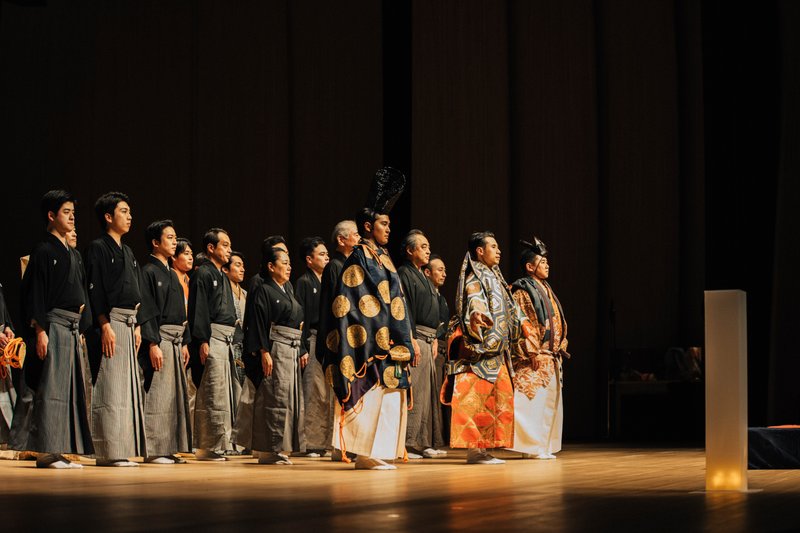
宝生流、アゼルバイジャンへ Vol.3 「舞台の上から見えた風景」 The Hosho School of Noh Theater in Azerbaijan Vol.3 “On Stage and Post Performance”
2月1日。本番当日。開演は午後7時に予定されていましたが、夕方5時半にはすでにヘイダル・アリエフ・センターに人が集まり、会場には期待にあふれるざわめきが広がっていました。その数時間前、一同は滞りなくリハーサルを終えていました。
The performance was set for 7PM but by 5:30 people were already filing into the theater and the buzz of expectancy was in the air. Just a couple of hours before that, rehearsals had gone smoothly.

この夜、披露されたのは3つの演目です。笛、小鼓、大鼓、太鼓の楽奏である「盤渉楽」。そして狂言「福の神」と、能「小鍛冶」。
That night, there were three performances: First there was 'Banshikigaku' which is an instrumental performance involving the tsudumi (handheld small and mid-size drums) the taiko, and Japanese flute. Secondly, there was the 'Kyogen' or comedy titled 'Fukuno Kami (God of Fortune)' and finally, the Noh play 'Kokaji (Swordsmith)' marked by the twin performances of the Hosho grandmaster


どの演目も、900人以上ものお客さまには大人気だったようで、狂言「福の神」では爆笑する人もいました。
「福の神」は、大晦日に神社に一年の幸福を祈願しに行った二人の男の話。どうすれば幸せになれるか話し合っているところに神様が現れ、「幸せになるための大きな柱のひとつは、神様にお神酒をお供えすることだ」と告げ、二人はそれに従います。アドの男二人は面をつけずに演じるので、そのコミカルな表情が多くの人に受けたようです。
The 900-strong audience appeared to love every minute of the performances and some people were laughing out loud at 'Fukuno Kami.' This is about two men who go up to a shrine on New Year's Eve to pray for happiness in the coming year. As they're discussing just how they can be happy, a god appears to tell them that one of the main pillars of happiness is to provide sake for the god, which they duly obey. Two of the main Kyogen actors did not wear masks and the comical expressions on their faces seemed to incite much comment.


旅の前、家元はアゼルバイジャンでの公演の目的について「コミュニケーションのきっかけをつくり、私たちの2つの文化が互いに分かり合える境地に到達したい」と話していましたが、この狂言「福の神」はまさにそのきっかけとなりました。アゼルバイジャンはワインの名産地です。イスラム教でありながら、お酒を楽しむ文化を持っている人々には、福の神の物語は十分に理解していただけるものでした。また、ゾロアスター教という古い宗教との繋がりがある土地柄、アゼルバイジャンの人たちには古代の神々や精霊に対する寛容さと理解もあったのです。
Before embarking on the journey, the grandmaster had said that the goal here was to “create an opportunity for communication and to encourage a rapport between the two cultures of Azerbaijan and Japan.” The grandmaster's choice of Kyogen had been spot-on. Even though Azerbaijan is Islamic, it is also wine country and people know how to enjoy a good bottle of wine. And the country's historical ties to Zoroastrianism indicated a tolerance and understanding of ancient deities and spirits.

そしてこの夜のフィナーレを飾ったのが能「小鍛冶」です。
京都の有名な刀鍛冶である宗近は、帝の使いから、急ぎ新しい剣を打つようにという命を受けます。承知する宗近ですが、ともに刀を鍛えるための相槌を打つ者がいません。宗近は稲荷神社に赴き、助けを求めて祈願します。すると神社には不思議な童が現れ、すべてがうまくいくから安心して用意をするように告げます。宗近が家に着き、剣を鍛える準備をしていると霊狐が現れ、宗近に相槌の技術を教わると、二人で一振りの剣を鍛え上げるのです。霊狐は足早に立ち去る際に、仕上がった剣の表面に神の印を入れてくれました。
'Kokaji' brought up the finale of the night. Munechika, a famed swordsmith in Kyoto gets word that the Emperor is in need of a new sword and it must be completed quickly. Munechika is willing but needs a partner swordsmith to hammer the molten iron with him. He goes to the Inari shrine that reveres the fox, to offer his prayers for good craftsmanship. A boy spirit appears at the shrine and tells him that all be well. Indeed, when Munechika reaches his home, the fox deity of the shrine appears. Together they craft the Emperor's sword under Munechika’s tutelage and all goes well. In the end, the god brands the sign of the fox onto the sword’s surface before making a rapid exit.

家元がこの「小鍛冶」を選んだのは、アゼルバイジャンがヨーロッパとアジアを往来する刀剣・貴金属貿易のシルクロードの拠点として栄えた歴史に敬意を表してのこと。またこの物語には火が象徴的に登場します。「火の国」と称され、拝火の歴史を持つアゼルバイジャンの人たちにとってもイメージしやすい演目であろうと家元は考えたのです。
家元みずから、前シテとして神の使いである不思議な童を、後シテとして霊狐を演じましたが、前シテは白と青の装束で若々しい雰囲気、後シテでは神秘的で威厳のある雰囲気。声でも動きでもその違いは明らかでした。
The grandmaster had selected 'Kokaji' in deference to Azerbaijan's history as a wealthy silk road hub where swords and other precious metals were transported back and forth between Europe and Asia. 'Kokaji' also has the element of fire, which the grandmaster surmised would evoke Azerbaijan's national icon and provide the audience with an entry into the story.
He performed both the twin lead roles of the boy spirit and the fox deity. For the former, he appeared in a white and baby blue kimono exuding a spry, youthful ambience. His latter performance was marked by mystery and authority. His voice, which was higher and sweeter for the boy, changed when he became the god and even his movements became weightier.


「小鍛冶」が終わり、全員が舞台袖に退場しても大きな拍手は鳴りやまず、一同はカーテンコールで再び舞台に姿を現しました。そして家元が披露したのが挨拶代わりの優美な跳躍。両足でぴたっと着地すると、劇場は再び歓声と拍手に包まれたのでした。
After this final performance the loud applause went on until the Hosho School took a curtain call. And then, as a parting farewell the grandmaster took one, graceful leap in the air and made a perfect landing on both feet upon which the theater erupted with cheers and clapping.


公演終了後、私たちは興奮冷めやらぬ観客のみなさんにロビーでインタビューをしました。今回の公演についてまずインタビューに答えてくれたのはラミヤさん(写真右)です。
「子どもの頃から日本は私の心の中で特別な国でした。今夜の演目は、私自身や私の人生にとても関わりがあるもののように感じました。とても神秘的でありながら、とても身近に感じられたんです。特に、『福の神』の演目では、なにか幸せのヒントをもらったような気がして、とても気に入りました」
After the curtains came down, we had a chance to speak with some in the audience who were milling in the lobby, their fervor and excitement as yet unabated. Lamiye who agreed to an interview, said: "Japan has held a special place in my heart since childhood. And seeing the performances tonight, I felt they were so relevant to me and to my life. They felt very mysterious and yet so close. I especially loved the Fuku no Kami performance because it gave me pointers on how to achieve happiness."

「招待状を受け取って、絶対に来なければと思いました」と話してくれたのはネイマヌさん(写真左)。颯爽とスーツを着こなして観劇に臨まれました。
「日本文化に接したのは初めてですが、アゼルバイジャンの文化と通じるものが多くあると感じました。両国とも非常に深い歴史を持っている。日本に住むってどんな感じなんだろうとずっと思っていたんですが、能や狂言がそれを表しているとしたら、とてもすばらしいものですね」
Neiman who came to the Center dressed in a dapper suit and tie, said: "I got the invitation for this and I thought, I must come here tonight. This is the first time I've had contact with Japanese culture and I felt that there is much in common with Azerbaijani culture. We both have very deep histories. I've always wondered what it was like to live in Japan and if Noh is any indication, I think it must be pretty wonderful over there."

バクー大学で日本語と日本文化を学んでいる19歳のセルジャンさん(写真中)にもお話を聞くことができました。「子どもの頃から日本に興味があったので、大学では日本学科に入学したんです。能や歌舞伎については本で読んだことがあるので、今夜は是非観たいと思っていました。能で好きなのは囃子です。私も音楽を学んでいますが、囃子はアゼルバイジャンの近くにあるカザフスタンの音楽と近いものがある気がします。カザフスタンの音楽も能と同じように自然からインスピレーションを受け、楽器を通して生き物の声を表現しているんです。能は精霊や神々との古くからの結びつきを本当に大切にし感謝の心を表しているのだと、私も感じました」【Vol.4に続く】Nineteen-year old Selcan who studies Japanese language and culture at Baku University, said: "I've been interested in Japan since I was a child which is why I enrolled in the Japanese Studies Department at my university. I've read about Noh and Kabuki so I was very keen to be here tonight. I think that what I love best about Noh is the 'hayashi.' I study music too and I feel that the 'hayashi' has a lot in common with the music of Kazakhstan which is near Azerbaijan. Like Noh, Kazakh music is inspired by nature and imitates animal sounds through their instruments. I felt too, that Noh really values and appreciates the ancient ties to spirits and gods."【Continued on Vol.4】

この記事が気に入ったらサポートをしてみませんか?
